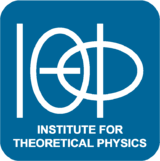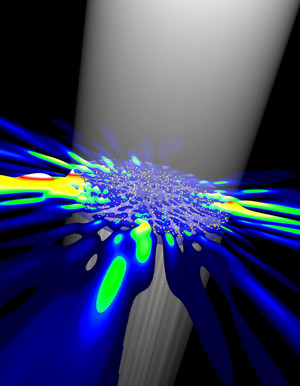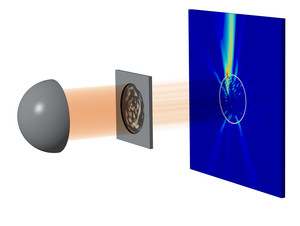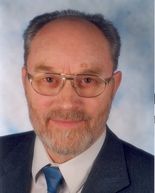
Institute for Theoretical Physics
| Line 22: | Line 22: | ||
> Ultrakurze Laserpulse kontrollieren chemische Prozesse<br> |
> Ultrakurze Laserpulse kontrollieren chemische Prozesse<br> |
||
> Schwingende Saiten zwischen zwei Buchdeckeln<br> |
> Schwingende Saiten zwischen zwei Buchdeckeln<br> |
||
| − | > Die schnellste Stoppuhr der Welt bald am CERN?<br> |
+ | > Die schnellste Stoppuhr der Welt - bald am CERN?<br> |
| − | > Der Molekül-Baukasten<br> |
+ | > Der Molekül-Baukasten; Strukturen, die sich selbst<br> |
| − | > Nano-Hillocks |
+ | > Nano-Hillocks: Wenn statt Löchern Berge wachsen<br> |
| − | > DACAM- |
+ | > DACAM - neues Center für atomistische Simulationen in Wien<br> |
<br> |
<br> |
||
Revision as of 11:29, 30 July 2013
Steuerbare Zufallslaser
Zufallslaser sind winzige Körnchen, die ihr Licht unkontrolliert in verschiedene Richtungen abstrahlen. An der TU Wien konnte nun gezeigt werden, dass man dem Zufall auf die Sprünge helfen kann um diese exotischen Lichtquellen präzise zu steuern.
Zufallslaser werden durch einen Lichtstrahl von oben mit Energie versorgt. Zufällige Unregelmäßigkeiten im Inneren (gelbe Punkte) sorgen dafür, dass das Laserlicht in ganz unterschiedliche Richtungen ausgestrahlt wird.
Hier wird der Lichtstrahl zuerst durch eine Maske geschickt, sodass nicht jeder Punkt im Zufallslaser (weißer Kreis) im selben Maß mit Energie versorgt wird. Durch dieses gezielte Pumpen emittiert der Zufallslaser einen Lichtstrahl genau in die gewünschte Richtung.
Mehr dazu auf unserer News-Seite sowie weitere stories;
> Ehrenmedaille für Prof. Maria Ebel
> Standing Ovations für den TU-Chor
> Möchten Sie Ihr schwarzes Loch mit Milch?
> Stefan Nagele - Promotion Sub Auspiciis
> Zwischen Physik und Chemie
> Quanteneffekte in Super-Zeitlupe
> 400.000 Euro für Schwarze Löcher + das holograph. Prinzip
> Gefrorenes Chaos
> Ultrakurze Laserpulse kontrollieren chemische Prozesse
> Schwingende Saiten zwischen zwei Buchdeckeln
> Die schnellste Stoppuhr der Welt - bald am CERN?
> Der Molekül-Baukasten; Strukturen, die sich selbst
> Nano-Hillocks: Wenn statt Löchern Berge wachsen
> DACAM - neues Center für atomistische Simulationen in Wien
Das Institut für Theoretische Physik trauert um sein früheres Mitglied,
wiss. Oberrat Dipl.-Ing. Dr. Gerhard ADAM
(8.12.1932 - 30.12.2012)
Research
The research program at our institute is characterized by a remarkable diversity covering a broad spectrum of topics ranging from high-energy physics and quantum field theory to atomic and condensed matter physics. As a focus area, non-linear dynamics of complex systems including aspects of quantum cryptography and quantum information plays an important role. Many of the research topics make use of and belong to the subdiscipline "computational physics".
The breadth of activities at our institute provides advanced students as well as young researchers with the opportunity to be exposed to a multitude of state-of the art research directions and to receive a broad-based academic training.
Access to query mask of the publication database of the Vienna University of Technology. Direct access to the most recent publications.
Teaching
Teaching theoretical physics to young colleagues is an important part of our activities. Physics nowadays is a very wide field of knowledge, which progresses with ever increasing pace. We are aware that teaching must be directed towards students specializing in experimental as well as in theoretical physics, and we are committed to Humboldt’s program of teaching science through practicing science.
Access to query mask of the teaching database of the Vienna University of Technology. Direct access to all courses offered by our institute.
Talks
Information on physics talks in Vienna can be found in the Calendar of Physics Talks.
Contact
- Institute for Theoretical Physics
- Vienna University of Technology
- Wiedner Hauptstrasse 8-10/136
- Tower B (yellow), 10th floor
- A-1040 Wien, AUSTRIA
- TEL +43 1 58801x13601, x13602 (secretariat)
- FAX +43 1 5880113699
- e-mail heike.hoeller (at) tuwien.ac.at




